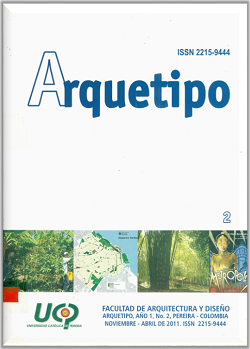Arquitectura mudéjar en la región del valle del Alto Cauca, Colombia (siglo XVIII): tipos y técnicas
Palabras clave:
Arquitectura mudéjar, arquitectura en el Valle Del Cauca, albañileríaResumen
Dos de los ejemplos más destacados de la arquitectura mudéjar que se levantó en el territorio de la Nueva Granada (hoy Colombia), se encuentran aun en pie en la región del valle del Alto Cauca: el primero de ellos es la torre de San Francisco, en Cali, que data de 1772? y constituye un importante monumento del mudejarismo tardío americano. El segundo es la torre anexa a la capilla de la población de El Salado, en la misma región, también del siglo XVIII y de la cual no existen documentos que permitan reconstruir su génesis histórica. En ambos casos se destaca el manejo del ladrillo como material de construcción a la vista, confirmando el hecho de que uno de los protagonistas de la arquitectura mudéjar en América será sin duda el albañil. Surgen entonces algunas preguntas que esta ponencia intentará resolver de manera muy breve y puntual: ¿de qué cuerpo de conocimientos debía valerse un constructor neogranadino del siglo XVIII para materializar ejemplos de estas características?, ¿de dónde obtenía las materias primas (arcillas y cales principalmente)?, ¿cuál fue su principal aporte a la arquitectura de la región donde prosperó?
Referencias
André, Edouard (1884). . Barcelona: Montaner Y Simón. Arbeláez, Carlos (1965). “La Catedral De Tunja”. En: Anales Del Instituto De Arte Americano E Investigaciones Estéticas, 18, Buenos Aires; Pp. 9-22.
Arbeláez, Carlos (1971). “La Casa Del Fundador En Tunja”. En: Anales Del Instituto De ArteAmericano E Investigaciones Estéticas, 24, Buenos Aires; Pp. 67-72
Barney, Benjamín (2002). “Mudejarismo Y Arquitectura En La Nueva Granada, Siglo XVIII”. En: Citce 4, Cali; Pp. 33-47.
Barney-Cabrera, Eugenio (1971). “Transculturación Y Mestizaje En El Arte En Colombia”. En: Temas Para La Historia Del Arte En Colombia, Bogotá, Imprenta Nacional; Pp. 45-67.
Buschiazzo, Mario (1961). Historia De La Arquitectura Colonial En Iberoamérica. Buenos Aires: Ed. Emecé
Corradine, Alberto (1989). Historia De LaArquitectura Colombiana. Bogotá: Ed. Escala. Gasparini, Graziano (1985). “Significado Presente De La Arquitectura Del Pasado”. En: Segre, Roberto: México, Ed. Siglo XXI; Pp. 143-169. Gutiérrez, Ramón (1992). Arquitectura Y Urbanismo En Iberoamérica. Buenos Aires: Ed. Cátedra.
López De Arenas, Diego (1912). Carpintería De Lo BlancoYTratado DeAlarifes. Madrid: Imp. De Los Hijos De R. Álvarez. Edición Prima En 1633. Sarasa, Esteban: “La Sociedad Mudéjar”. En: Lacarra, María Del Carmen (Coord.): Arte Mudéjar En Aragón. León, Castilla, Extremadura Y Andalucía. Zaragoza: Institución Fernando El Católico; Pp. 7-29.
Sebastián, Santiago (1962). “El Mudejarismo En Colombia: La Torre De Santiago De Cali”. En: 5, Bogotá; Pp. 533-542.
Sebastián, Santiago (1965). Arquitectura Colonial En Popayán Y El Valle Del Cauca. Cali: Universidad Del Valle.
Toussain, Miguel (1945). . México: Ed. Porrúa.
